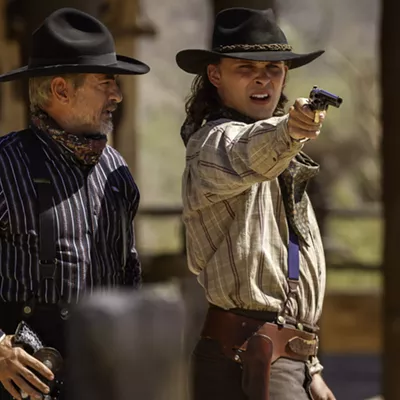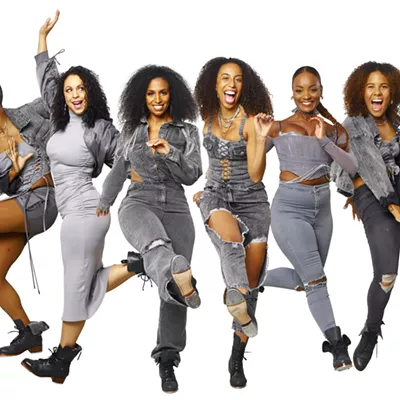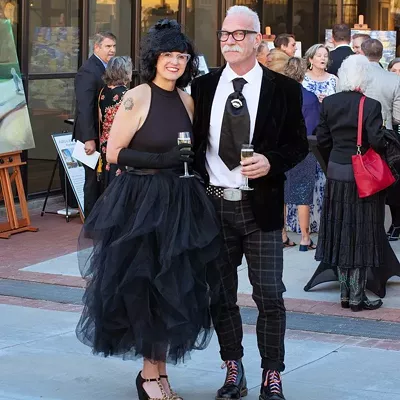Each year, in the dark of December, ZUZI! Dance stages a Solstice celebration.
The shortest day of the year, with the longest night, Solstice also marks the return of the light, the point in the calendar when the hours of winter sun lengthen and begin to outshine the shadows.
Traditional cultures honor this day (on Wed., Dec. 21, this year), and ZUZI! artistic director Nanette Robinson typically choreographs a concert inspired by folk Solstice practices from around the world.
This year's The Four Directions, the 19th edition of the Solstice show, has all the usual ZUZI! components: aerial dance on the trapeze and modern movement on the floor, a mix of professional, community and kid dancers, live musical interludes, and light piercing the darkness.
But for the first time a guest choreographer is directing the show and creating most of the dances.
"I'm having a blast with this show," says Billbob Brown, a Tucson newcomer who's thrilled to have found dance work so quickly in his new home. Brown, who's also a video artist, brings a solid dance resume to the task. A co-founder of the respected Desert Dance Theatre in Phoenix, Brown taught in the dance program at UMass Amherst for 22 years, the last five as department head. His most recent gig was a year teaching dance in Hong Kong.
He and his spouse discovered Tucson after a "four-month journey around the country," Brown says. "We paused in Tucson and it was an instant love affair. We fell in love with the yards, the landscape, the mountain views, the food" and the Spanish they hear in the streets.
Brown had already been working on ideas for an evening-length Four Directions show—about humans starting out in one place in the world, he says, and "spreading out to the four directions"—when he and Robinson met and clicked.
"It felt like a meant-to-be moment," Robinson says. "When he talked about the project he had been mulling over, it resonated with me as a great theme for this year's Solstice. Originally I thought we might codirect but he had such a clear vision of what he wanted to accomplish, I felt it was important for him to take the lead."
Brown has created six dances for the show, while Robinson contributed three, including a dance about water and an aerial dance for kids, with the input of ZUZI! aerial teacher Aja Squires. Robinson also collaborated on a community work for non-pros, with Arts for All and Karenne Koo, who also dances in the show.
While most of the dances are performed to recorded music, guitarist Pablo Peregrina and vocalist Sally Withers will perform musical interludes between the dances.
Brown is relishing the fact that ZUZI! has its own theater, a "wonderful space," where he's free to leisurely compose his dances and tinker with the digital projections that make up the set.
"At heart I'm a choreographer and a digital artist," he explains.
"Multiply-imaged video projections" will be directed onto 9-foot towers on stage. Images suggesting the four compass points, North, South, East and West will flicker on the boxes, along with others evoking the four elements of the ancient world: earth, air, water and fire.
"The video supports what the dancers are doing," he sets. "The sets will become, variously, towers of fire, or serene grottos, waterfalls, or occasionally, psychedelic meanderings of light and symbol,"
Narrator Jasmine Roth helps tell the story about the "journey we've been taking on this planet for 100,000 years," Brown says. "Homo sapiens began in Africa, and people started migrating to the Middle East, to China and across the Bering Strait."
The work is not directly inspired by the thousands of refugees fleeing from Syria into Europe and from Central America into the United States in recent years, he says. But it's meant to remind us that large movements of people "have been going on for thousands of years. Where we're having difficulties is when our paths have criss-crossed." He tackled the sometimes tough subject because he wants "to make dance meaningful to the larger world."
Brown himself dances in "Civil War (VS vs US)," a solo from a larger works about "racisms and other-isms" that he premiered at Desert Dance Theatre. He's working intensively with four local dancers, Sherry Mulholland, Sabrina Geoffrion, Bethanne Griffin and Koo.
"They're beautiful and exquisite," he says, "They have charisma and focus."
Brown trained in the Bill Evans technique and studied at both the Martha Graham and Alvin Ailey studios. Lately he's immersed himself in gaga, the dance practice pioneered by revered Israeli choreographer Ohad Naharin.
"It gives dancers a sense of freedom he says. It's about non-linearity. The way we move is the way trees grow."
"My work is challenging for the dancers," he adds. "They're loving it. I'm making dances on their bodies, taking their bodies places they've never been before."











